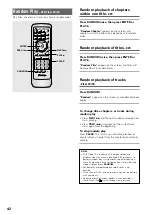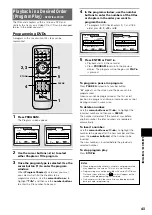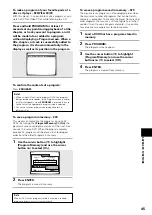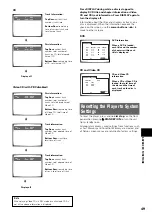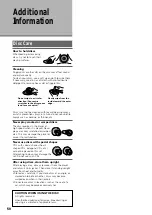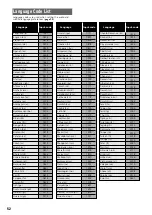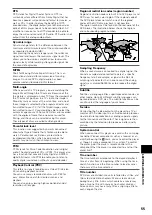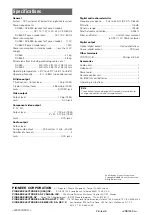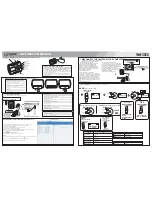
55
ADDITIONAL INFORMA
TION
Regional restriction codes (region number)
Regional restriction codes are built in to DVD players and
DVD discs for each sales region. If the regional code of
the DVD player does not match one of the regional
codes of the DVD disc, playback is not possible.
The region number can be found on the rear panel of the
DVD player. The illustration below shows the regions
and corresponding region numbers.
Sampling Frequency
When a sound wave is converted to a digital signal, the
sound is sampled and converted to data at a specific
frequency rate. For example, a signal with a 96 kHz
sampling rate indicates that in one second, the analog
signal was sampled 96000 times to produce the digital
signal.
Subtitle
Subtitles are language titles superimposed on movies, or
other media. Up to 32 different subtitle languages can
be recorded on a DVD disc. The subtitle function can be
used to select the language of your choice.
S-video
Connecting the S-video output on the player to a TV or
monitor with S-video input via an S-video cable produces
clearer picture reproduction by sending separate signals
for the luminance and the color. These signals are then
combined by the television to produce a better quality
picture.
System control
When you connect this player via a cord with a mini plug
to another Pioneer component such as a receiver or an
amplifier bearing the
Î
mark, you can control the player
as though it were a component in a system. To control
the player, point the player’s remote control at the
component that the player is connected to, and not the
player itself.
Time number
The time number corresponds to the elapsed playback
time of a disc from its beginning. When using the time
search function, use the time number to locate scenes
that occur at the time selected.
Title number
DVD discs are divided into units referred to as titles, and
titles are divided into chapters. Menu screens do not
belong to any title. A disc which contains a movie may
have only one title with many or no chapter divisions.
Karaoke discs may have many titles, assigning a title to
each song on the disc.
DTS
DTS stands for Digital Theater System. DTS is a
surround system different from Dolby Digital that has
become a popular surround sound format for movies, as
well as CDs. In order to enjoy the benefits of DTS
encoded discs, the digital output jack (either coaxial or
optical) of this player needs to be connected to an AV
amplifier or receiver or to a DTS decoder to be able to
enjoy the surround sound of DTS audio. DTS audio is not
output from the analog audio outputs.
Dynamic range
Dynamic range refers to the difference between the
maximum and minimum levels of the audio soundtrack
as measured in decibels (dB).
Compressing the dynamic range raises the minimum
signal level and lowers the maximum signal level. This
allows you to hear voices and other low level audio
signals clearly while lowering strong audio signals like
the sound of explosions.
MPEG
Short for Moving Picture Experts Group. This is an
international standard for compression of moving
images. On some DVDs, digital audio has been
compressed and recorded in this format.
Multi-angle
When you watch a TV program, you are watching the
image filmed through the TV camera. Because of this,
the picture is displayed on your TV from the viewpoint of
the TV camera’s position. In a TV studio, the image is
filmed by many cameras at the same time, and one of
those images is selected by the program director and
transmitted to your TV. If all the filmed images were
transmitted to your TV you would be able to select the
camera image you want. Some DVD discs are recorded
with the angles of more than one camera used for
filming, and these can be selected using this player.
These types of discs are called multi-angle discs.
Parental lock level
This function was suggested by parents concerned
about what type of media their children were able to
watch. Parental lock restrictions are restrictions
incorporated into titles which include scenes that
parents may not wish their children to view.
PCM
PCM stands for Pulse Code Modulation and is digital
audio. The digital audio of CDs is PCM. This player also
has a function that converts Dolby Digital and MPEG
digital bitstreams into PCM to enable you to listen to
quality digital sound even without a special decoder.
Playback Control (PBC)
This refers to signals recorded on a Video CD (Version
2.0) enabling playback control.
You can use menus recorded on discs with PBC for
easy, interactive search for desired scenes, and
playback.
You can also enjoy viewing high-resolution/standard
resolution still images.


